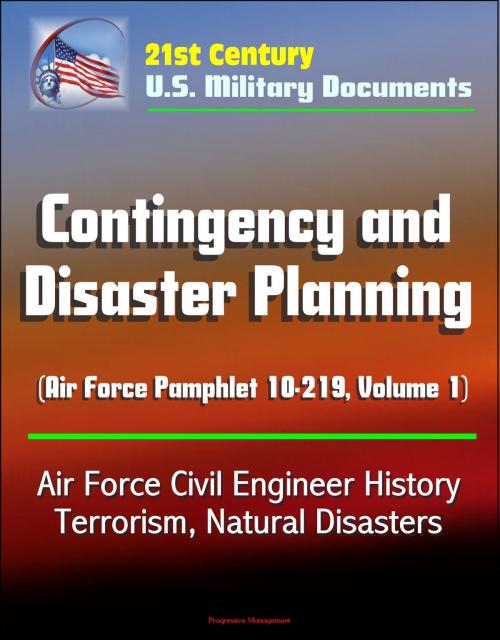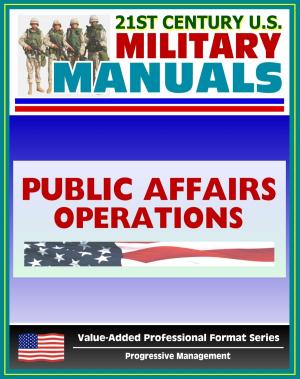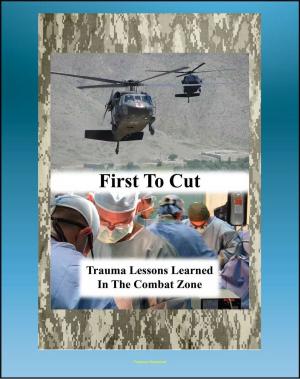21st Century U.S. Military Documents: Contingency and Disaster Planning (Air Force Pamphlet 10-219, Volume 1) - Air Force Civil Engineer History, Terrorism, Natural Disasters
Nonfiction, History, Military, Aviation, Social & Cultural Studies, Social Science| Author: | Progressive Management | ISBN: | 9781301204694 |
| Publisher: | Progressive Management | Publication: | October 13, 2013 |
| Imprint: | Smashwords Edition | Language: | English |
| Author: | Progressive Management |
| ISBN: | 9781301204694 |
| Publisher: | Progressive Management |
| Publication: | October 13, 2013 |
| Imprint: | Smashwords Edition |
| Language: | English |
This Air Force document discusses contingencies for which civil engineers must be prepared. It contains practical information to help unit-level civil engineers plan their responses to contingencies, disasters, war, and other military operations. It explains how to identify requirements and get resources; to organize civil engineer response teams; and to train and exercise those teams. It concludes by presenting a brief history of Air Force Civil Engineers. It applies to all Civil Engineers, including Air National Guard (ANG) units and Air Force Reserve Command (AFRC).
Topics covered include: natural disasters affecting Air Force bases, man-made disasters, chemical warfare, biological warfare, terrorism, PRIME BEEF, RED HORSE.
Chapter 1 * DISASTERS AND CONTINGENCIES * 1.1. Introduction * 1.2. Overview * 1.3. Natural Disaster * 1.4. Man-Made Disasters * 1.5. Hostile Actions * 1.6. Operations Other Than War * 1.7. Air Force Involvement * 1.8. Civil Engineers' Role * 1.9. Off-Base Support * 1.10. The Need for Planning * 1.11. Summary * Chapter 2 * MAKING PLANS * 2.1. Introduction * 2.2. Overview * 2.3. Major Planning Efforts * 2.4. Formal Plans * 2.5. CE Contingency Response Plan Guidance * 2.6. Support To and From Others * 2.7. Formal and Informal Agreements * 2.8. Environmental Protection Considerations * 2.9. Checklists * 2.10. Whose Job Is It To Plan? * 2.11. Hints for Plan Development * 2.12. Plan Updates * 2.13. Sources of Information * 2.14. Summary * Chapter 3 * RESOURCES * 3.1. Introduction * 3.2. Overview * 3.3. Personnel * 3.4. Supplies and Equipment * 3.5. Vehicles * 3.6. Air Force Contract Augmentation Program (AFCAP) * 3.7. Summary * Chapter 4 * ORGANIZING TO RESPOND * 4.1. Introduction * 4.2. Overview * 4.3. Base Organization for Disaster Response * 4.4. Civil Engineer Squadron * 4.5. Civil Engineer Response Teams * 4.6. Bomb Threat * 4.7. Major Natural Disaster * 4.8. Base Recovery Operations—Initial Response * 4.9. Thoughts on Organizing Teams * 4.10. Augmenting Forces * 4.11. Summary * Chapter 5 * TRAINING * 5.1. Introduction * 5.2. Overview * 5.3. CE Training Requirements * 5.4. Individual Training * 5.5. Home Station Training * 5.6. Silver Flag * 5.7. Special Training Programs * 5.8. Ideas about CE Contingency Training * 5.9. Summary * Chapter 6 * EXERCISES, EVALUATIONS, AND INSPECTIONS * 6.1. Introduction * 6.2. Overview * 6.3. Civil Engineer Involvement * 6.4. Local Exercises * 6.5. Planning the Exercise (CE portion) * 6.6. Higher Headquarters Exercises * 6.7. Benefits of Hosting Major Exercises * 6.8. Evaluations * 6.9. Inspections and Assessments * 6.10. Summary * Chapter 7 * INFORMATION COLLECTION, RECORDS, AND FORMS * 7.1. Information Collections * 7.2. Records * 7.3. Forms (Adopted and Prescribed) * Attachment 1— GLOSSARY OF REFERENCES AND SUPPORTING INFORMATION * Attachment 2— PREPARING CIVIL ENGINEER CONTINGENCY RESPONSE PLANS * Attachment 3— STEPS IN PLAN DEVELOPMENT * Attachment 4— OUR FOUNDATIONS: A HISTORY OF AIR FORCE CIVIL ENGINEERS
This pamphlet has been updated and changed to add significant historic accomplishments of United States Air Force (USAF) civil engineer (CE) personnel during the 1990s through 2007; specifically in regards to Operations ALLIED FORCE, ENDURING FREEDOM and IRAQI FREEDOM. Significant changes were incorporated regarding planning for deployments supporting other than USAF units, terrorist threats and chemical, biological, radiological, nuclear, and high yield explosives (CBRNE) events. The update also incorporates Air Force Incident Management System (AFIMS) guidance for planners as related to Homeland Security Presidential Directive (HSPD-5 ) mandating the use of the National Response Plan and National Incident Management System as planning source documents.
This Air Force document discusses contingencies for which civil engineers must be prepared. It contains practical information to help unit-level civil engineers plan their responses to contingencies, disasters, war, and other military operations. It explains how to identify requirements and get resources; to organize civil engineer response teams; and to train and exercise those teams. It concludes by presenting a brief history of Air Force Civil Engineers. It applies to all Civil Engineers, including Air National Guard (ANG) units and Air Force Reserve Command (AFRC).
Topics covered include: natural disasters affecting Air Force bases, man-made disasters, chemical warfare, biological warfare, terrorism, PRIME BEEF, RED HORSE.
Chapter 1 * DISASTERS AND CONTINGENCIES * 1.1. Introduction * 1.2. Overview * 1.3. Natural Disaster * 1.4. Man-Made Disasters * 1.5. Hostile Actions * 1.6. Operations Other Than War * 1.7. Air Force Involvement * 1.8. Civil Engineers' Role * 1.9. Off-Base Support * 1.10. The Need for Planning * 1.11. Summary * Chapter 2 * MAKING PLANS * 2.1. Introduction * 2.2. Overview * 2.3. Major Planning Efforts * 2.4. Formal Plans * 2.5. CE Contingency Response Plan Guidance * 2.6. Support To and From Others * 2.7. Formal and Informal Agreements * 2.8. Environmental Protection Considerations * 2.9. Checklists * 2.10. Whose Job Is It To Plan? * 2.11. Hints for Plan Development * 2.12. Plan Updates * 2.13. Sources of Information * 2.14. Summary * Chapter 3 * RESOURCES * 3.1. Introduction * 3.2. Overview * 3.3. Personnel * 3.4. Supplies and Equipment * 3.5. Vehicles * 3.6. Air Force Contract Augmentation Program (AFCAP) * 3.7. Summary * Chapter 4 * ORGANIZING TO RESPOND * 4.1. Introduction * 4.2. Overview * 4.3. Base Organization for Disaster Response * 4.4. Civil Engineer Squadron * 4.5. Civil Engineer Response Teams * 4.6. Bomb Threat * 4.7. Major Natural Disaster * 4.8. Base Recovery Operations—Initial Response * 4.9. Thoughts on Organizing Teams * 4.10. Augmenting Forces * 4.11. Summary * Chapter 5 * TRAINING * 5.1. Introduction * 5.2. Overview * 5.3. CE Training Requirements * 5.4. Individual Training * 5.5. Home Station Training * 5.6. Silver Flag * 5.7. Special Training Programs * 5.8. Ideas about CE Contingency Training * 5.9. Summary * Chapter 6 * EXERCISES, EVALUATIONS, AND INSPECTIONS * 6.1. Introduction * 6.2. Overview * 6.3. Civil Engineer Involvement * 6.4. Local Exercises * 6.5. Planning the Exercise (CE portion) * 6.6. Higher Headquarters Exercises * 6.7. Benefits of Hosting Major Exercises * 6.8. Evaluations * 6.9. Inspections and Assessments * 6.10. Summary * Chapter 7 * INFORMATION COLLECTION, RECORDS, AND FORMS * 7.1. Information Collections * 7.2. Records * 7.3. Forms (Adopted and Prescribed) * Attachment 1— GLOSSARY OF REFERENCES AND SUPPORTING INFORMATION * Attachment 2— PREPARING CIVIL ENGINEER CONTINGENCY RESPONSE PLANS * Attachment 3— STEPS IN PLAN DEVELOPMENT * Attachment 4— OUR FOUNDATIONS: A HISTORY OF AIR FORCE CIVIL ENGINEERS
This pamphlet has been updated and changed to add significant historic accomplishments of United States Air Force (USAF) civil engineer (CE) personnel during the 1990s through 2007; specifically in regards to Operations ALLIED FORCE, ENDURING FREEDOM and IRAQI FREEDOM. Significant changes were incorporated regarding planning for deployments supporting other than USAF units, terrorist threats and chemical, biological, radiological, nuclear, and high yield explosives (CBRNE) events. The update also incorporates Air Force Incident Management System (AFIMS) guidance for planners as related to Homeland Security Presidential Directive (HSPD-5 ) mandating the use of the National Response Plan and National Incident Management System as planning source documents.















